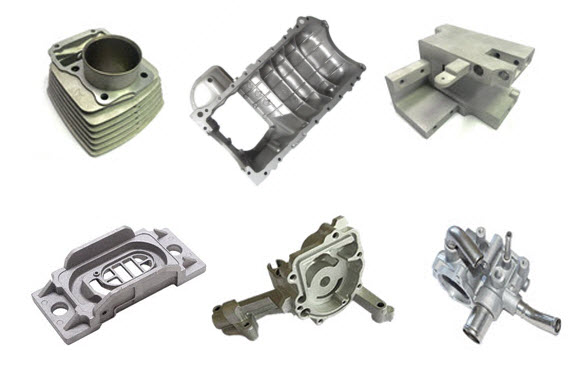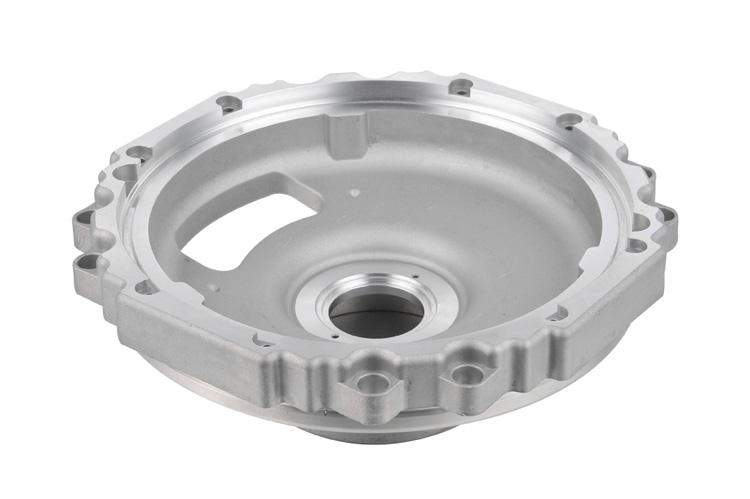The impact of Aluminum Foundry technology in industrial production
Wiki Article
All About Aluminum Castings: Comprehending Their Role and Importance in Manufacturing
Aluminum spreadings are essential to modern-day manufacturing, offering a mix of lightweight residential properties and sturdiness. They help with intricate styles while minimizing setting up prices. Industries such as automotive and aerospace frequently make use of these elements for enhanced efficiency. Nevertheless, the production of light weight aluminum spreadings is not without its challenges. Comprehending the subtleties of this process exposes both the advantages and possible pitfalls. Checking out these elements will certainly offer much deeper insights right into their growing value.Introduction of Aluminum Casting Processes
Light weight aluminum casting procedures play a necessary duty in manufacturing, supplying adaptability and efficiency. These processes include putting molten light weight aluminum into mold and mildews to develop accurate shapes and parts. Various methods are used, including sand spreading, die casting, and financial investment spreading, each distinguished by its technique of mold and mildew creation and the intended application.Sand casting makes use of a blend of sand and binder to form mold and mildews, permitting complicated geometries. Pass away casting, on the various other hand, includes compeling liquified light weight aluminum right into steel mold and mildews, causing high precision and smooth coatings. Investment casting, commonly used for elaborate styles, includes producing a wax pattern covered with a ceramic covering, which is after that loaded with molten aluminum.
These casting methods accommodate diverse commercial needs, making light weight aluminum a favored material for components in markets such as auto, aerospace, and durable goods. The option of casting method greatly affects the end product's high quality and efficiency.
Advantages of Using Aluminum Castings
The benefits of using light weight aluminum spreadings in production are many and substantial. To begin with, aluminum's lightweight nature adds to lowered general product weight, enhancing power effectiveness in applications such as auto and aerospace markets. Furthermore, aluminum spreadings display excellent deterioration resistance, making certain durability and resilience in severe settings. The material's thermal and electrical conductivity also makes it appropriate for numerous applications, consisting of electronics and warm exchangers.Furthermore, aluminum castings can be produced with intricate layouts, permitting much more intricate forms that meet certain practical needs. This convenience adds to reduced setting up costs and boosted style flexibility. In addition, the spreading process itself is efficient, enabling high-volume manufacturing with consistent top quality. Ultimately, aluminum is recyclable, making it an eco-friendly choice in production. Jointly, these benefits highlight why light weight aluminum spreadings are significantly favored across varied markets, offering both performance benefits and financial efficiency.
Typical Applications of Light Weight Aluminum Castings
While various materials are utilized in production, aluminum castings stand apart as a result of their broad series of applications throughout numerous industries. These castings are commonly utilized in the auto sector for engine components, transmission housings, and architectural parts, contributing to lighter automobiles and boosted gas efficiency. In the aerospace market, aluminum castings are important for airplane parts, where weight decrease is crucial for performance and safety.Additionally, the electric industry employs aluminum spreadings for real estates and architectural components in machinery, profiting from the product's superb conductivity. In customer items, light weight aluminum spreadings can be located in products such as home appliances and sporting tools, offering toughness and a modern visual. The building and construction sector uses aluminum spreadings in building elements, home window frames, and fixtures, showcasing their versatility and toughness. Generally, light weight aluminum spreadings play an indispensable duty in improving product efficiency and effectiveness across numerous industries.
Trick Production Techniques for Aluminum Castings
The production of aluminum castings depends on different techniques, with sand spreading and pass away spreading being among one of the most popular. Sand casting entails producing molds from sand, enabling for intricate styles and big components. On the other hand, pass away casting utilizes high-pressure shot of liquified aluminum right into multiple-use mold and mildews, supplying accuracy and efficiency for automation.Sand Spreading Process
Sand spreading stands as one of the most commonly made use of methods for creating light weight aluminum spreadings, thanks to its flexibility and cost-effectiveness. This procedure involves developing a mold and mildew from a mix of sand and a bonding representative, usually clay. As soon as the mold and mildew is ready, molten aluminum is put right into it, permitting the steel to fill the cavity. After cooling, the mold and mildew is broken away to reveal the spreading. Sand spreading suits complicated geometries and big components, making it appropriate for numerous applications. In addition, it allows for easy adjustments, making it possible for manufacturers to adjust designs swiftly. Nevertheless, the surface finish may require extra machining for exact applications, making certain the end product satisfies top quality criteria.Die Spreading Approaches
Pass away spreading represents an extremely efficient method for producing light weight aluminum spreadings, defined by its capability to supply high accuracy and excellent surface area coating. This method mostly includes forcing molten light weight aluminum right into a mold under high pressure, making sure that great details and elaborate shapes are recorded precisely. There are two main die spreading techniques: hot chamber and cold chamber. Warm chamber pass away spreading appropriates for alloys with low melting factors and enables for faster cycles, while cold chamber pass away spreading is excellent for high-temperature alloys, needing separate melting systems. Both techniques boost manufacturing rates and lower material waste, making pass away casting a preferred selection check these guys out in industries such as auto and electronics, where resilience and dimensional precision are paramount.Sustainability in Light Weight Aluminum Casting Production
While the need for aluminum spreadings continues to grow, manufacturers are significantly prioritizing sustainability in their manufacturing processes. This change is driven by the need to lower environmental influence and conserve natural sources. Lots of firms are embracing reusing efforts, making use of scrap aluminum, which significantly lowers energy intake and greenhouse gas exhausts contrasted to primary aluminum production. Furthermore, developments in casting modern technologies are allowing a lot more efficient use of products, minimizing waste during the production procedure.Manufacturers are also checking out green choices to typical spreading approaches, such as 3D printing and progressed mold innovations, which aid optimize resource usage. Metal Castings. In enhancement, implementing sustainable practices in supply chain administration warranties that raw products are sourced responsibly. Therefore, the light weight aluminum spreading sector is making strides towards a much more lasting future, straightening with international ecological objectives while fulfilling the raising need for high-performance light weight aluminum products
Obstacles and Considerations in Aluminum Casting
Light weight aluminum casting presents various obstacles that suppliers have to browse to assure item stability. Design intricacy can make complex the casting process, causing prospective problems and enhanced production time. In addition, preserving rigorous quality assurance requirements is important to fulfill the demands of accuracy and dependability in completed elements.
Design Complexity Issues
Designing elements for aluminum casting presents numerous intricacies that designers need to browse to achieve perfect results. One significant difficulty is the demand for precise geometry; intricate layouts can bring about problems in mold and mildew development and increased risk of problems. Furthermore, thermal properties of light weight aluminum require careful factor to consider of cooling rates, as irregular cooling can create bending. Wall density variants additionally posture a difficulty, as they can impact circulation attributes and architectural honesty. Engineers must stabilize design looks with manufacturability, making certain that functions such as fillets and ribs are enhanced for stamina without complicating the spreading procedure. Considerations pertaining to draft angles are try this necessary to assist in mold launch, further making complex the layout process. These aspects jointly underscore the complexities associated with light weight aluminum spreading design.Top Quality Control Challenges
Accomplishing top quality light weight aluminum spreadings involves navigating a variety of quality assurance difficulties that can substantially impact the end product. First, variants in resources structure can bring about disparities in casting residential or commercial properties, making it necessary to assure worldly top quality. Second, the spreading procedure itself is at risk to defects, such as porosity and shrinking, which can jeopardize structural stability. Additionally, temperature control during melting and pouring is crucial; fluctuations can result in unequal solidification, affecting dimensional precision. In addition, comprehensive assessment methods, consisting of non-destructive testing, must be utilized to determine flaws early. Maintaining rigid process paperwork and adherence to market criteria is indispensable for traceability and top quality guarantee, highlighting the detailed balance required to generate trustworthy light weight aluminum castings in production.Future Patterns in Aluminum Casting Technology
As suppliers seek to enhance efficiency and sustainability, advancements in light weight aluminum casting modern technology are arising to fulfill these demands. One substantial pattern is the combination of automation and artificial intelligence, which enhance manufacturing processes and enhance accuracy in casting procedures. These advancements lessen human error and enhance resource use, inevitably causing cost reductions.In addition, the adoption of advanced products and alloys is improving the landscape. New formulations enhance performance attributes, such as rust resistance and lightweight properties, making aluminum castings extra versatile across numerous markets.
In addition, sustainable methods are getting grip, with a focus on recycling and reducing waste. Techniques such as 3D printing are also being checked out to create intricate geometries that were previously unattainable
Regularly Asked Questions

Just How Do Light Weight Aluminum Castings Compare to Various Other Materials?
Aluminum castings supply advantages such as lightweight, corrosion resistance, and exceptional thermal conductivity compared to other products. They are typically favored for applications calling for sturdiness and performance, particularly in aerospace and vehicle markets.What Is the Life-span of Light Weight Aluminum Castings?
The lifespan of light weight find this aluminum castings generally ranges from 10 to half a century, relying on ecological problems, use, and maintenance. Their rust resistance and sturdiness contribute visibly to their lasting efficiency in different applications.Can Light Weight Aluminum Castings Be Reused?
Yes, light weight aluminum spreadings can be recycled. The recycling procedure is reliable, permitting for the healing of aluminum without significant loss of top quality, making it a lasting option in production and reducing ecological impact.What Security Measures Are Needed Throughout Light Weight Aluminum Casting?
Throughout aluminum spreading, important precaution include wearing ideal personal protective tools, making sure correct ventilation, preserving tools, utilizing fireproof materials, and carrying out risk-free dealing with methods for molten metal to stop injuries and mishaps.Exactly How Do Temperature Modifications Affect Light Weight Aluminum Castings?
Temperature level changes significantly influence aluminum spreadings by affecting fluidness, solidification prices, and mechanical homes. Rapid air conditioning can result in raised brittleness, while progressive cooling promotes better architectural honesty and lowers the danger of flaws.Die spreading, on the various other hand, involves requiring liquified light weight aluminum right into steel mold and mildews, resulting in high precision and smooth finishes. The manufacturing of aluminum castings counts on different strategies, with sand casting and pass away casting being amongst the most prominent. Sand casting stands as one of the most commonly made use of methods for creating aluminum castings, thanks to its adaptability and cost-effectiveness. Die casting represents a highly efficient approach for creating light weight aluminum spreadings, characterized by its ability to provide high accuracy and outstanding surface finish. While the need for light weight aluminum castings continues to expand, makers are increasingly focusing on sustainability in their production procedures.
Report this wiki page